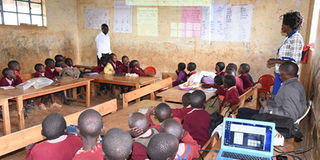Curriculum change should be done right

Pupils of Tebeswet Primary School in Uasin Gishu participate in a math lesson under the new curriculum on May 20, 2019. Some individuals say the implementation of the learning system was rushed. PHOTO | JARED NYATAYA | NATION MEDIA GROUP
What you need to know:
- A majority of Kenyan public schools don't even have basic amenities such as standard buildings and proper toilets for any kind of progressive learning.
- It is possible to avoid an unnecessary education disaster if we start listening to voices that say major elements of the curriculum are damaging.
It is indeed true that the rigid 8-4-4 system of education, introduced in 1985, needs re-evaluation as its content is purely exam-oriented.
However, overhauling an entire system and introducing a competency-based curriculum does not seem to be the right solution.
From the outset, expert groups questioned why extensive consultation was not done and why the new curriculum was benchmarked on countries like South Africa and Malaysia, which had gone this route and failed.
The new curriculum is supposed to replace the exam-oriented 8-4-4 with a competency-based system whose greatest controversy is on its competitiveness and measurement.
First, the new curriculum is inclined towards science, technology, engineering and mathematics (Stem) for those who make it to the upper secondary level. This could be a mistake because Stem alone cannot create competent, self-sufficient learners.
INFRASTRUCTURE
Secondly, there are concerns on how to practically and effectively measure competencies that the new curriculum is based on.
Then there is the question of whether the time allocated for this shift is adequate.
There seems to be a hurried approach, which is not going to make the rollout possible without major disruption — but of course no one is listening.
Thirdly, a fundamental worry on what is really needed for a successful rollout emerged because one of the reasons the old curriculum was reported to be failing was the lack of schools, which is still an existing problem.
Currently, a majority of Kenyan public schools don't even have basic amenities such as standard buildings, clean water, proper toilets, electricity, desks and stationery for any kind of progressive learning. What of implementing a whole new curriculum?
CONSULTATION
At the same time, there aren’t enough properly trained teachers equipped to deliver the new curriculum.
Parents are also required to play a huge part by, for example, downloading and printing school work that contributes 60 per cent of their child’s overall assessment — this in a country where internet penetration and cost, access to computers and printers is low.
All this is baffling, to say the least. Because however good the new curriculum’s intentions might be, if not done right it will end up irredeemably affecting many Kenyan children.
It is possible to avoid an unnecessary education disaster if we start listening to voices that say major elements of the curriculum are damaging.
There's nothing wrong with taking time and allowing a gradual process to guide this huge system change.
We honestly owe it to all the Kenyan children to better protect them from any educational damage — because they are already carrying so much burden.
The writer is a policy analyst; [email protected]





